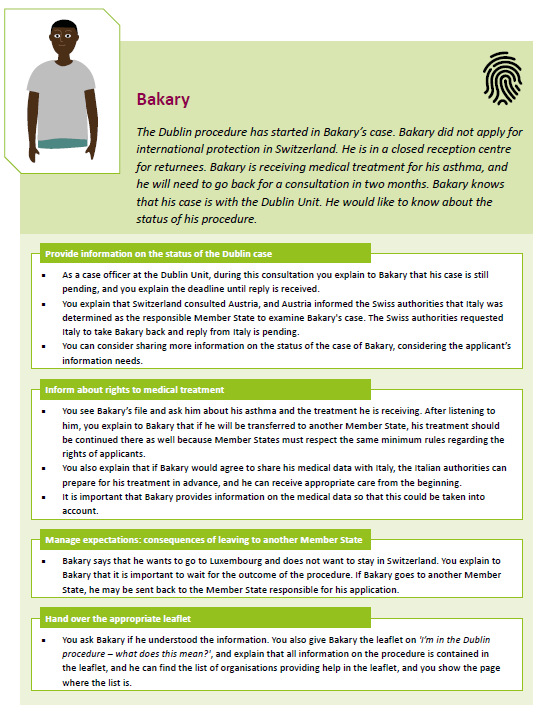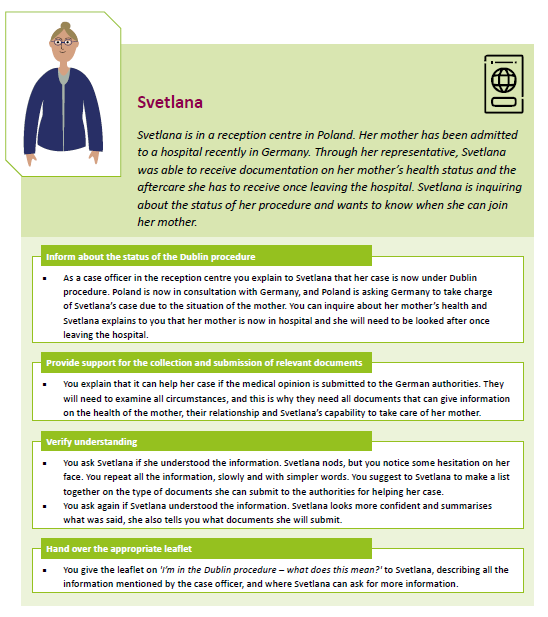The time it takes to determine the responsible Member State can vary considerably from case to case. However, the regulation provides that the process for determination should take place as soon as possible. This part covers information provision during the Dublin interview as well as additional information that the applicant may need during the determination process. It also covers information provided to the applicant in cases where the determining Member State becomes the responsible Member State.
When conducting a Dublin interview at the same time as, or shortly after the lodging of the application, this part and the preceding part on the lodging can be read together. It is important to note that repetition of information is important to ensure the proper understanding by the applicant.
Key information to be provided during the Dublin personal Interview
Explain your role, the purpose of the Dublin procedure, its main steps and the responsibility criteria.
The applicant may be transferred from one country where the application is lodged to another country that is responsible for examining the application. Remind them as well of the territorial scope of the Dublin III regulation. It is applied in 31 countries. The Dublin procedure guarantees that the application for international protection will be examined by the authority of one of the countries participating in the Dublin system and ensures that an applicant does not make multiple applications in several countries with the aim of extending their stay in the Member States.
Explain that the examination of the application for international protection starts once a Member State is determined to be responsible, or when the applicant arrives in the Member State responsible following a transfer.
Applicants that are eager to tell you about what happened to them in their country of origin may be disappointed that you are not asking about this. Explain that this will be dealt with in full once a responsible country has been determined. Make sure to also provide some information on the time limits in the Dublin procedure (see Annex III. Timelines of the Dublin III regulation).
The criteria for determining the responsible Member State.
Remind the applicant about the criteria for determining the Member State responsible, and their hierarchy, notably the family criteria, dependency and humanitarian clause. Note that if the applicant does not want to be reunited with family members in another Member State, it is not necessarily the case that the application will be handled where the applicant is currently present. It could be another Member State based on other criteria.
The importance of providing information about family members
Remind the applicant of the importance to provide the authorities with all the information that the applicant has about the presence of any family members or relatives in any of the Member States. Remind the applicant as well of the importance of providing any other information which the applicant thinks could be relevant for establishing the country responsible for examining their application. The applicant should also provide any documents or papers in their possession that contain relevant information. Remind the applicant that cooperating with the authorities is in the best interests of both the applicant and the authorities. Remind the applicant that it is important that they are truthful and answer all questions to the best of their ability.
Be perceptive and proactive with regards to any special needs that the applicant may have.
Explain what help the applicant can receive, which organisations or authorities that are responsible for providing such services and how they can be accessed by the applicant. The applicant should inform the authorities of any special needs they might have.
Information materials
If the applicant is an adult and was previously provided with part A of the common leaflets (I have asked for asylum in the EU – Which country will handle my claim?) it could now be a good time to ensure that they are also provided with part B of the common leaflets (I’m in the Dublin procedure – what does this mean?). Part B of the common leaflets is intended for adult applicants that are in the Dublin procedure.
A continuous process of information provision
The time it takes from the start of the Dublin procedure until a transfer decision is taken, or the determining Member State assumes responsibility, can vary greatly from case to case. The registration and Dublin interviews can be used for building trust between the applicant and authority as well as other entities cooperating with the authorities. This might make the applicant more likely to turn to official sources of information. The ability of an applicant to reach out to the authorities with their questions during the procedure can also depend on factors such as whether the applicant is staying in a reception centre or not, if they have access to other assistance through legal aid, representatives or civil society organisations (CSOs).
When the determining Member State is the responsible Member State
The Dublin procedure does not always end with a transfer. For various reasons, the determining Member State can be the responsible Member State. When this happens, it is important to inform the applicant of this development and the continued procedure with regards to the examination of their application for international protection. In this case, it could also be important to inform the applicant about the consequences of absconding according to the provisions in your Member State.
Character: Bakary

Character: Svetlana
